Buschow K.H.J. (Ed.) Concise Encyclopedia of Magnetic and Superconducting Materials
Подождите немного. Документ загружается.


down-spin bands, can be neglected under ordinary
conditions (at least at low fields). Note that the spin
component could be basically viewed as arising from
the two-carrier (up- and down-spin carriers) model
with different relaxation times described above. The
skew scattering mechanism can be understood within
the classical picture as a deflection of the electron
trajectory by an angle y after the scattering through
spin–orbit coupling. The side jump mechanism is ba-
sically a quantum effect, which can be viewed as a
side step of the center of gravity of a wave packet, as
shown in Fig. 4, as an analogy.
The difference in the two mechanisms is reflected in
the dependence of each term on the resistivity r
(Hurd 1972): the anomalous Hall coefficient R
S
is the
sum of the skew scattering term proportional to r
and the side-jump term proportional to r
2
:
R
S
¼ ar þ br
2
ð12Þ
The electron scattering on only static imperfections
(like impurities) was initially considered as the origin
of the anomalous Hall effect in measurements of the
impurity concentration dependence of R
H
, where the
residual resistivity r
0
is employed in Eqn. (12).
Later on, it has been extended to the scattering by
thermal spin disorder and/or by phonons, both ex-
perimentally and theoretically (Irkhin and Shavrov
1962, Kondorskii 1965). In most theories, the mag-
netic part of the resistivity r
mag
is assumed to be
inserted in Eqn. (12), although it is not always easy to
separate the nonmagnetic contribution from the total
resistivity. In rare-earth intermetallic compounds,
r
mag
is usually obtained by subtracting the resistivity
r
ref
(T) of nonmagnetic reference compound from the
total resistivity r
tot
(T) as:
r
mag
ðTÞ¼r
tot
ðTÞr
ref
ðTÞð13Þ
It should be noted, however, that for the itinerant
magnetic electrons model, the relation, R
S
Br
2
tot
, was
theoretically reported for the thermal phonon or spin
disorder scattering at elevated temperatures (Hurd
1972).
(b) Kondo systems
The skew scattering theory based on the Coqblin–
Schrieffer model (1969) was first proposed by Fert
(1973), and was successfully applied to explain the
Hall effect in dilute lanthanum–cerium alloys. For
cerium compounds, Coleman et al. (1985) have given
an explanation of the large anomalous Hall constant
in terms of skew scattering by impurities, based on
the resonance-level model assuming a strong spin–
orbit coupling in the two limits of TbT
K
and T5T
K
.
Later, Fert and Levy (1987) formulated the more
generalized form, which describes experiments rea-
sonably well in a wider temperature range from
T4T
K
to T5T
K
. The Hall coefficient from the in-
trinsic skew scattering was given by the following
general expression:
R
S
ðTÞ¼gw
red
ðTÞr
r
ðTÞð14Þ
where w
red
(T){¼3k
B
w/(gm
B
)
2
j(j þ1)} is the reduced
susceptibility, r
r
(T) is the resistivity due to the res-
onant scattering. The coefficient g takes different val-
ues g
1
and g
2
above and below T
K
, related to the
phase shifts d
l
for channel l:
g
1
¼ð5=7Þgm
B
k
1
B
sind
2
cosd
2
ð15aÞ
for TbT
K
, and
g
2
¼ð5p=21Þgm
B
k
1
B
sinð2d
3
d
2
Þsind
2
=sin
2
d
3
ð15bÞ
for TbT
K
.
Fert and Levy (1987) have succeeded in reproduc-
ing the experimental temperature dependence of R
H
in typical heavy-Fermion compounds such as CeAl
3
and CeCu
6
. Even for the coherent state, they found
that Eqn. (14) accounts for the main features of the
Hall effect.
For the coherent state, Kontani and Yamada
(1994) first derived a formula for the anomalous Hall
coefficient, based on the Fermi liquid theory. The
anomalous part of the Hall coefficient is described as:
R
S
¼ Cw
enh
r
2
ð16Þ
Figure 4
Schematic comparison of skew-scattering and side-jump
scattering.
Figure 3
A typical example of Hall resistivity in a ferromagnetic
thin plate.
330
Intermetallics: Hall Effect
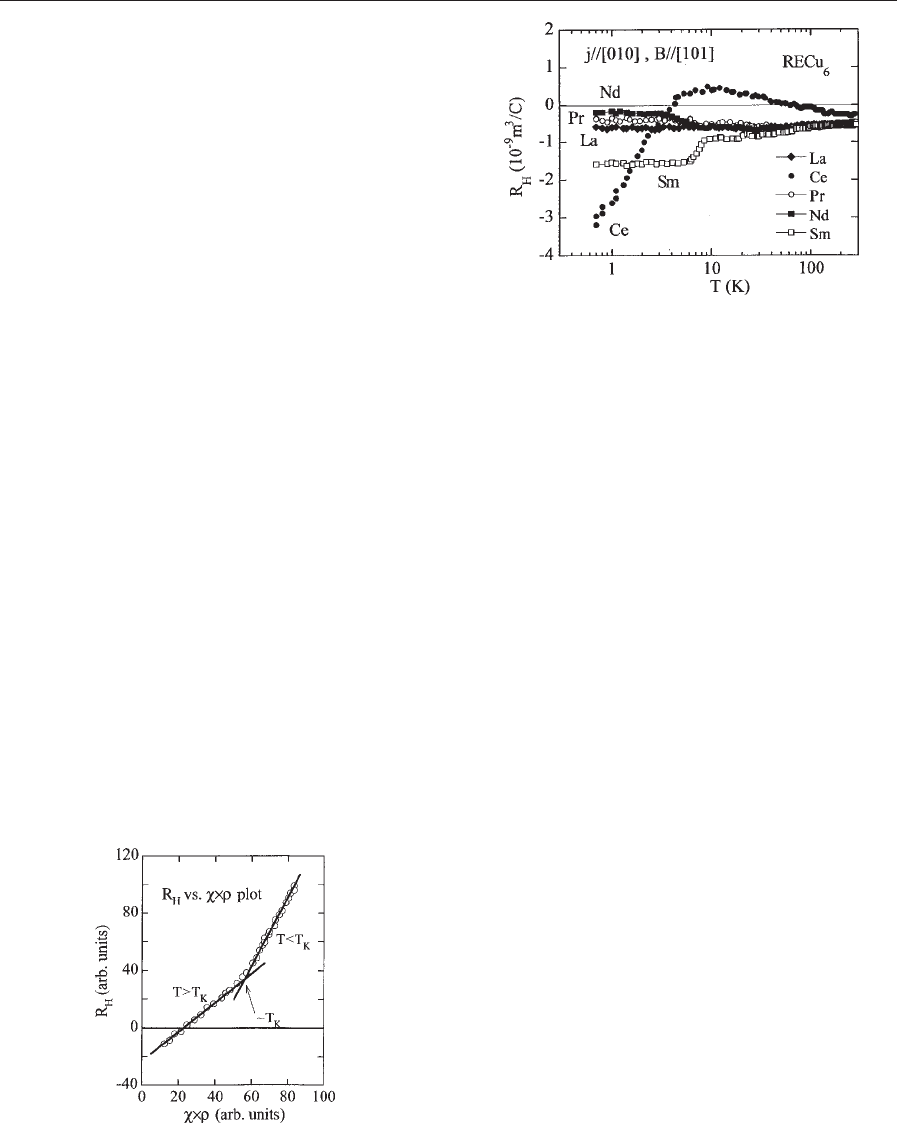
where the electrical resistivity follows r ¼r
0
þAT
2
and w
enh
is the enhancement factor proportional to
the magnetic susceptibility (see Electron Systems:
Strong Correlations).
3. Typical Experimental Results
Firstly, the most important factors for analyzing the
temperature dependence of Hall coefficient in Kondo
systems can be summarized as follows.
From the viewpoint of reliability of the analysis,
R
H
(T ), w(T ), and r(T ) should be measured on the
same sample and with the same geometry, which
reduces the errors due to unknown sources. For
compounds with an anisotropic crystal structure,
measurements on single crystals are essential. The
magnetic contribution to the measured resistivity
r
exp
(T ) could be estimated by subtracting the resis-
tivity r
ref
(T ) of a proper reference compound (for
example, a lanthanum analog for a cerium com-
pound) as:
r
mag
ðTÞ¼r
exp
ðTÞr
ref
ðTÞð17Þ
Using r
mag
(T ) thus obtained, R
H
(T ) is plotted
against w(T ) r
mag
(T ) as shown in Fig. 5. The slopes
in the two linear regions above T
K
and below T
K
give
g
1
and g
2
in Eqns. (15a) and (15b).
3.1 Well-localized 4f Compounds
The series RECu
6
(RE: La, Pr, Nd, and Sm) was
selected as a typical example for the well-localized
system. Fig. 6 shows the temperature dependence of
R
H
in RECu
6
for the light rare-earth elements (
Onuki
et al . 1989). At high temperatures, R
H
is only weakly
temperature-dependent for all the compounds except
CeCu
6
. For all the compounds, R
H
is approaching
5 10
10
m
3
C
1
, which should be the normal part
of the Hall coefficient. The negative sign of R
H
sug-
gests that the relaxation time for the carriers with
electron-like Fermi surface curvatures, positive r
1
in
Eqn. (7), is larger than that for the hole-like Fermi
surface curvatures, since RECu
6
is a compensated
metal with the same volume for both electron-like
and hole-like Fermi surfaces.
R
H
for NdCu
6
and SmCu
6
shows a clear change at
the corresponding Ne
´
el temperatures T
N
of 6 K and
9 K, respectively. At T
N
, two possible contributions
coexist; namely the change in the carrier concentra-
tion resulting from the AF super-zone gap formation,
and the change in anisotropy in the relaxation time.
For SmCu
6
, taking into account the fact that the
change in R
H
is steep, while that in r is gradual, the
two contributions compete in r and cooperate in R
H
.
The unique behavior in CeCu
6
results from the
dominant Kondo scattering in this compound, which
will be discussed below.
3.2 Cerium–Kondo Systems at Higher Temperatures
(Ce
x
La
1x
Cu
6
, CeRu
2
Si
2
, etc.)
Among the rare-earth intermetallic compounds, the
works on the Hall effect were rather limited to the
Kondo or heavy-Fermion compounds, mainly cerium
and ytterbium compounds (Cattaneo 1985,
Onuki
et al. 1993). Here, we concentrate on the current un-
derstanding of the Hall effect in cerium compounds,
based on typical examples in correlation with the
reported theories.
To start with, the Hall coefficient of Ce
x
La
1x
Cu
6
,
which has been the most systematically investigated,
is best suited for comparison with the skew scatter-
ing theory. Figure 7 shows the comparison of the
temperature dependences of R
H
in the experiment
with Eqn. (14) for selected values of cerium con-
centration. Here, the magnetic contribution to the
resistivity, r
m
(T ), has been estimated by subtracting
the resistivity r
nm
(T ) of a LaCu
6
sample from the
Figure 6
Temperature dependence of R
H
in RECu
6.
Figure 5
Schematic figure showing how to estimate g
1
and g
2
from
the experimental R
H
.
331
Intermetallics: Hall Ef fect
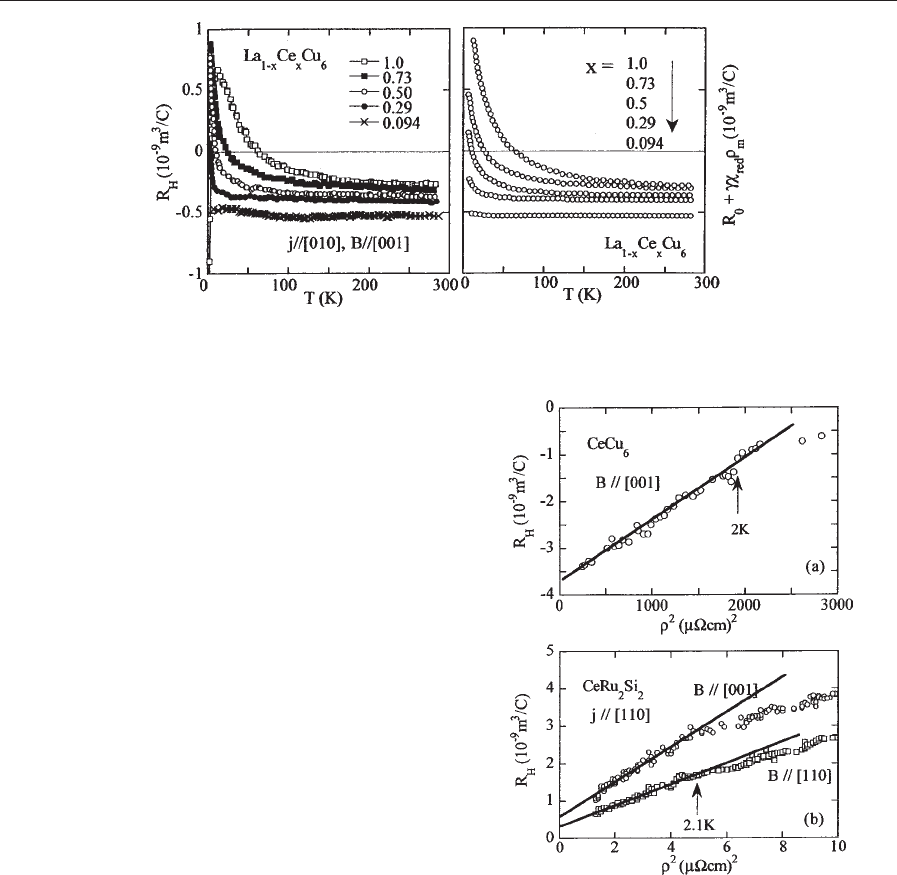
experimental one: r
exp
(T ); r
m
(T ) ¼r
exp
(T )r
nm
(T ).
w
red
¼w/C is estimated by using the experimental val-
ue of w. It should be noted that the experimental
curves could be fitted by almost the same value of the
phase shift d
2
E0.02 for all cerium concentrations.
The agreement is quite good over a wide temperature
range. Even for pure CeCu
6
, the agreement is satis-
factory above B20 K, below which the development
of the coherent state naturally leads to a different
conduction electron state. However, it is not easy to
separate the intrinsic skew scattering contribution
only from this figure, since a large anisotropy in R
H
at low temperatures could be expected.
For the coherent state, the scaling relation
Eqn. (16) has been tested in selected heavy-Fermion
systems. The results for CeCu
6
and CeRu
2
Si
2
are
shown in Fig. 8, where the linearity is reasonably
good for the lowest temperatures (
Onuki et al. 1993).
For CeRu
2
Si
2
, there has been a controversy over
the difference in the anisotropy between the anom-
alous Hall coefficient and the magnetic susceptibility:
the anisotropy in R
H
is small in contrast to the large
anisotropy in w, reflecting the crystalline electric field
(CEF) of the 4f levels. This fact opens the question of
whether the temperature dependence of R
H
is caused
by the skew scattering contribution to the anomalous
Hall effect or not. Kontani et al. have explained
the difference in the anisotropy as being due to the
different contribution from the higher excited CEF
levels to w and R
H
(Kontani et al. 1997). However, in
order to fully understand the heavy-Fermion state,
more systematic investigations on high-quality single
crystals are necessary.
3.3 Uranium Intermetallic Compounds
(UNiGa, UCoAl, UPd
3
)
UNiGa is one of the typical compounds whose
Hall effect has been successfully utilized to solve
important issues (Kobayashi et al. 1996). At low
temperatures, uranium moments order ferromagnet-
ically within the basal plane sheets with a strong
uniaxial anisotropy along the c-axis. An antiferro-
magnetic (AF) structure, characterized by c-axis
stacking of the type (mmkmkk), is stabilized.
A magnetic field applied along the c-axis induces a
first-order type metamagnetic transition leading to a
ferromagnetic (F) stacking, accompanied by a large
resistance change across the metamagnetic transition
Figure 7
Comparison of R
H
in the experiment with Eqn. (14) for La
1x
Ce
x
Cu
6
.
Figure 8
R
H
versus r
2
plots for CeCu
6
and CeRu
2
Si
2
at low
temperatures.
332
Intermetallics: Hall Effect
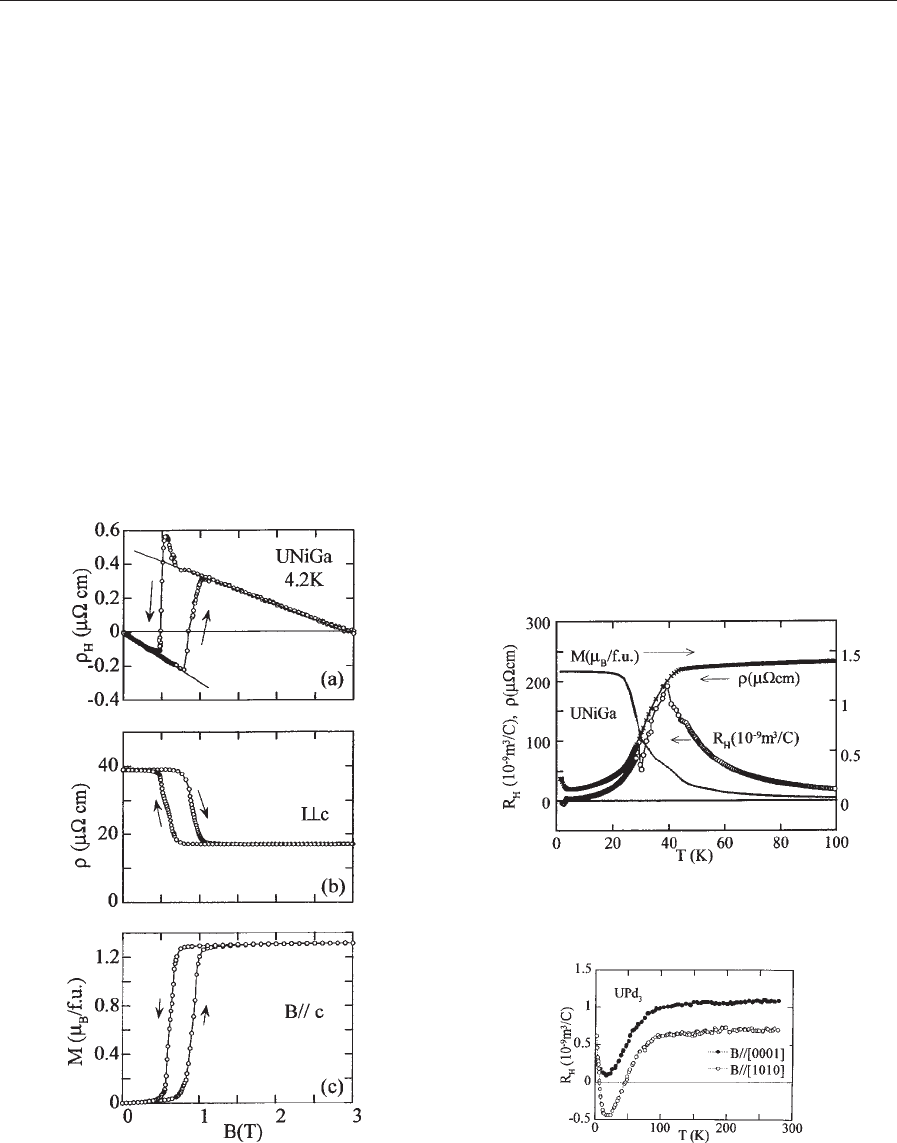
(Sechovsky et al. 1991). Spin-dependent scattering
was initially thought to be the origin of the large
magnetoresistance, since it bears a geometrical re-
semblance to the giant magnetoresistance (GMR) in
artificial magnetic superlattices.
Another plausible explanation of the large magne-
toresistance is based on the Fermi surface reconstruc-
tion due to the disappearance of the AF super-zone
gap. This was initially rejected from results of specific
heat measurements (Sechovsky et al. 1993), where no
clear change in C/T was observed across the meta-
magnetic transition.
The measurement of Hall effect has been used as a
powerful tool to judge the origin of the large mag-
netoresistance (Kobayashi et al. 1996). Figure 9
shows the field dependence of R
H
across the meta-
magnetic transition at 4.2 K, along with the magnet-
ization and magnetoresistance measured on the same
sample in the same geometry. Fortunately, R
S
is
practically field-independent at low and high fields,
except close to the metamagnetic transition, since
both M and r are almost constant due to the strong
uniaxial anisotropy. Therefore, the normal Hall
coefficient R
H0
below and above the metamagnetic
transition can be determined from the slopes in the
two regions. R
H0
changes from 2.9 10
9
m
3
C
1
in
the AF state to 1.7 10
9
m
3
C
1
in the F state,
which gives evidence of a Fermi surface change across
the metamagnetic transition. Based on this fact, the
specific heat was remeasured, and a clear change of
the g value was found from 43 mJ K
2
mol
1
below to
48 mJ K
2
mol
1
above the metamagnetic transition.
This corroborates the scenario of the Fermi surface
reconstruction across the metamagnetic transition.
Another important issue on this material is the
itinerancy of 5f electrons. The temperature depend-
ence of R
H
for UNiGa is shown in Fig. 10, along with
those of r(T) and M(T).
It is meaningful to compare this result with those
obtained on UPd
3
. The latter compound was con-
firmed to be a typical 5f-localized system, based on an
inelastic neutron scattering experiment. The temper-
ature dependences of R
H
for B:[0001] and [1010]
are shown in Fig. 11 (
Onuki et al. 1993). One promi-
nent feature of these figures is the large difference in
the temperature-dependent part of R
H
between the
two compounds. That in UNiGa is about two orders
of magnitude larger than that in UPd
3
. This fact
strongly suggests that the 5f electrons responsible for
the magnetism are itinerant in UNiGa, while they are
localized in UPd
3
.
Figure 9
Field dependence of r
H
, r, and M in UNiGa at 4.2 K.
Figure 10
Temperature dependence of r, R
H
and M in UNiGa.
Figure 11
Temperature dependence of R
H
in UPd
3
.
333
Intermetallics: Hall Ef fect
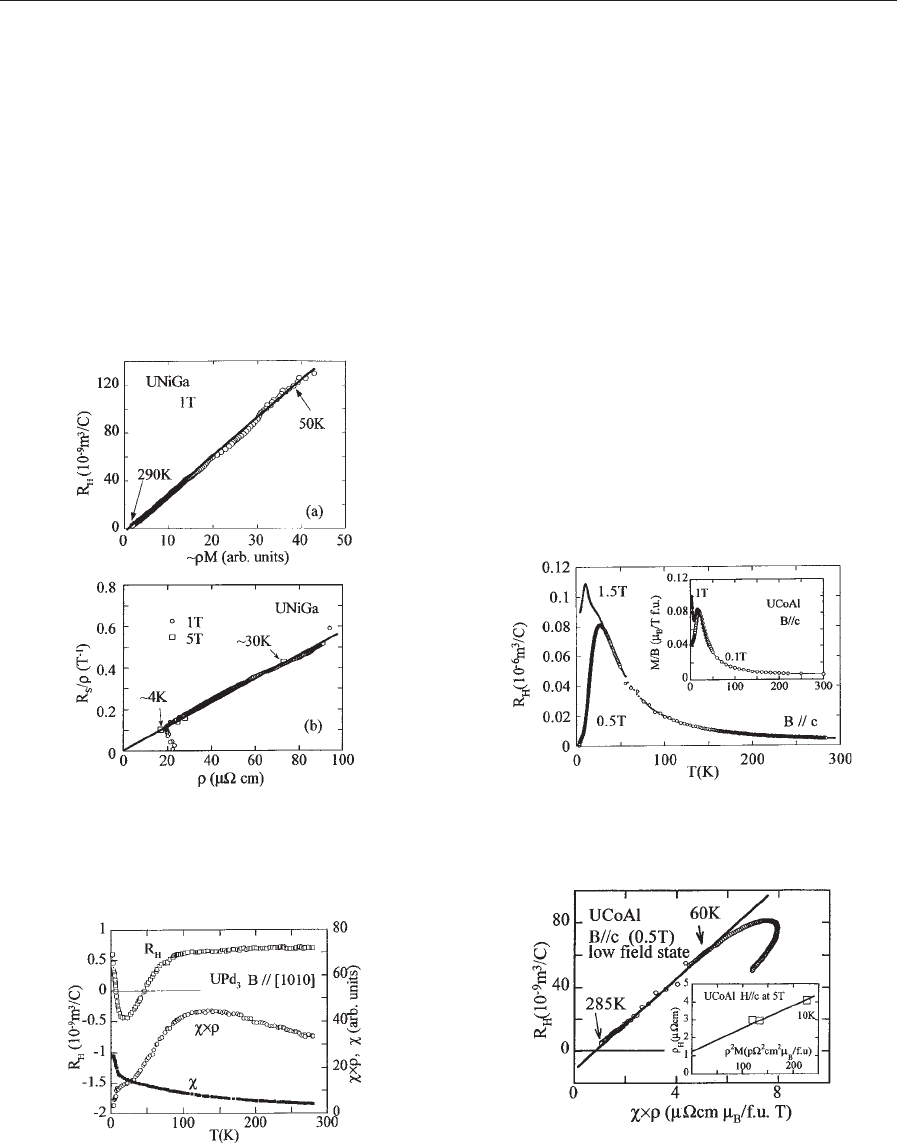
In the paramagnetic state, R
H
for UNiGa varies
linearly as rM, as expected from Eqn. (14), while in
the ferromagnetically aligned state at low tempera-
tures, R
S
/r is linear, passing through zero as a func-
tion of r (Fig. 12). Namely, in the high field state, the
side jump scattering in Eqn. (12) dominates, resem-
bling 3d ferromagnetic materials with a strong elec-
tron scattering. It should be also noted that such
good linear relations were found experimentally by
using the total resistivity, as was theoretically ob-
tained for the itinerant magnetic system (Irkhin
and Shavrov 1962), in many uranium compounds
(without subtracting the nonmagnetic component).
In contrast, no simple correlation was found be-
tween R
H
, w, and r for UPd
3
, as shown in Fig. 13,
which can be understood if the contribution from the
temperature-dependent anisotropic relaxation time
masks a small skew scattering contribution. This fact
is another evidence of the localized character of the 5f
electrons (at least there is only very little hybridiza-
tion) in this compound.
Another example of 5f-itinerant compounds is
UCoAl (Sato et al. 1998), which is a rare example
exhibiting a metamagnetic transition from the para-
magnetic ground state. The mechanism of the meta-
magnetic transition in typical 3d metamagnets, such
as YCo
2
and LuCo
2
, is well understood in terms of
itinerant-electron metamagnetism resulting from the
high 3d-band density of states near the Fermi level
(Goto et al. 1994). A close resemblance of UCoAl to
the 3d-itinerant metamagnets has been invoked,
based on intensive studies of the effect of alloying
and pressure on the metamagnetic transition. Figure
14 shows the temperature dependence of R
H
for two
different values of the magnetic field. The inset shows
M/B measured on a same sample. The temperature
dependences of the two properties resemble each
other, which becomes more apparent in the R
H
vs. wr
plot in Fig. 15. In the wide temperature range above
60 K, R
H
is linear against wr, as expected for the skew
Figure 12
(a) R
H
versus rM plot and (b) R
S
/r versus r plot for
UNiGa.
Figure 13
Temperature dependences of R
H
, w, wr in UPd
3
.
Figure 14
Temperature dependence of R
H
in UCoAl.
Figure 15
R
H
versus wr plot for UCoAl. The inset shows r
H
versus
r
2
M plot at high fields.
334
Intermetallics: Hall Effect

scattering mechanism. This fact, as well as the large
magnitude of R
H
, suggests the 5f electrons to be
itinerant.
The field dependence at low temperatures in
Fig. 14 reflects the metamagnetic transition. Figure
16 shows the field dependence of resistance, Hall re-
sistivity and magnetization for UCoAl on the same
sample and under the same conditions. We note an
apparent resemblance between the Hall resistivity
and the magnetization curves. Note that in the field-
induced ferromagnetic state, r
H
varies as r
2
(the inset
of Fig. 15). Across the metamagnetic transition
field, the transverse magnetoresistance shows a clear
decrease with increasing field, while an increase in
the resistivity has been reported for the longitudinal
geometry. This can be understood to be a so-called
anisotropic magnetoresistance resulting from the an-
isotropy in the spin–orbit coupling, which is common
in 3d-ferromagnetic metals and alloys. This fact also
suggests that UCoAl is in a 5f-band split ferromag-
netic state above the metamagnetic transition field.
The change in the density of states due to
the band splitting was further manifested in the field
dependence of specific heat as a decrease of C/T
(Matsuda et al. 1999).
4. Concluding Remarks
The Hall effect in intermetallics is not always analy-
zed straightforwardly. However, depending on the
system, it has the potential to give important infor-
mation on the electronic structure, which can hardly
be extracted by other experimental techniques. In
order to accomplish this, a proper analysis including
the separation of different contributions, e.g., either
normal or anomalous, is essential.
See also:5f Electron Systems: Magnetic Properties;
Heavy-fermion Systems; Intermediate Valence Sys-
tems; Kondo Systems and Heavy-fermions: Trans-
port Phenomena
Bibliography
Berger L, Bergmann G 1980 The Hall effect of ferromagnets.
In: Chien C L, Westgate C R (eds.) The Hall Effect and its
Applications. Plenum, New York, pp. 55–76
Cattaneo E 1985 Hall effect of some intermediate-valent Ce and
Yb compounds. Z. Phys. 47/48, 529–31
Chambers R G 1976 Transport properties: surface and size ef-
fect. In: Ziman J M (ed.) The Physics of Metals. Cambridge
University Press, London, pp. 175
Coleman P, Anderson P W, Ramakrishnan T V 1985 Theory
for the anomalous Hall constant of mixed-valence systems.
Phys. Rev. Lett. 55, 414–7
Coqblin B, Schrieffer J R 1969 Exchange interaction in alloys
with cerium impurities. Phys Rev. 185, 847–53
Fert A 1973 Skew scattering in alloys with cerium impurities.
J. Phys. F: Met. Phys. 3, 2126–42
Fert A, Friederic A, Hamzic A 1981 Hall effect in dilute mag-
netic alloys. J. Magn. Magn. Mater. 24, 231–57
Fert A, Hamzic A 1980 Hall effect from skew scattering by
magnetic impurities. In: Chien C L, Westgate C R (eds.)
The Hall Effect and its Applications. Plenum, New York,
pp. 77–98
Fert A, Levy P M 1987 Theory of the Hall effect in heavy-
fermion compounds. Phys. Rev. B 36, 1907–16
Goto T, Aruga Katori H, Sakakibara T, Mitamura H,
Fukamichi K, Murata K 1994 Itinerant electron metamag-
netism and related phenomena in Co-based intermetallic
compounds. J. Appl. Phys. 76, 6682–7
Hurd C M 1972 The Hall Effect in Metals and Alloys. Plenum,
New York
Hurd C M 1980 ‘‘Pressing electricity’’: a hundred years of
Hall effect in crystalline metals and alloys. In: Chien C L,
Westgate C R (eds.) The Hall Effect and Its Applications.
Plenum, New York, pp. 1–54
Irkhin Yu P, Shavrov V G 1962 Theory of the spontaneous Hall
effect in ferromagnets. Sov. Phys. JETP 15, 854–8
Kobayashi Y, Aoki Y, Sugawara H, Sato H, Sechovsky V,
Havela L, Prokes K, Mihalik M, Menovsky A 1996 Hall
effect and thermoelectric power in UNiGa. Phys. Rev. B 54,
15330–4
Kondo J 1962 Anomalous Hall effect and magnetoresistance of
ferromagnetic metals. Prog. Theor. Phys. 27, 772–90
Kondorskii E I 1965 Role of electron scattering by phonons
and magnetic inhomogeneities in the Hall effect in ferromag-
netic metals. Sov. Phys. JETP 21, 337–41
Kontani H, Miyazawa M, Yamada K 1997 Theory of anom-
alous Hall effect in a heavy-fermion system with a strong
anisotropic crystal field. J. Phys. Soc. Jpn. 66, 2252–5
Kontani H, Yamada K 1994 Theory of anomalous Hall effect
in heavy-fermion system. J. Phys. Soc. Jpn. 63, 2627–52
Matsuda T D, Aoki Y, Sugawara H, Sato H, Andreev A V,
Sechovsky V 1999 Specific heat anomaly around metamag-
netic transition in UCoAl. J. Phys. Soc. Jpn. 68, 3922–6
Onuki Y, Yamazaki T, Ukon I, Komatsubara T, Umezawa A,
Kwok W K, Crabtree G W, Hinks D G 1989 Anomalous
Hall coefficient in the f-electron systems—U compounds.
J. Phys. Soc. Jpn. 58, 2119–25
Onuki Y, Yun S W, Satoh K, Sugawara H, Sato H 1993
Anomalous Hall coefficient in the f-electron system. In: Oomi
G, Fujii H, Fujita T (eds.) Transport and Thermal Properties
of f-Electron Systems. Plenum, New York, pp. 103–11
Sato H, Aoki Y, Matsuda T D, Sugawara H, Kobayashi Y,
Andreev A V, Sechovsky´ V, Havela V, Settai R,
Onuki
Y 1998 Transport and thermal properties across phase
Figure 16
Field dependence of r, r
H
, and M in UCoAl at
4.2 K.
335
Intermetallics: Hall Ef fect

transitions in f-electron systems. In: Kazimierski M (ed.) 11th
Sem. Phase Transitions and Critical Phenomena. Polish Acad-
emy of Sciences, Wroclaw, Poland, pp. 23–33
Sechovsky´ V, Havela L, de Boer F R, Bru
¨
ck E, Suzuki T, Ikeda
S, Nishigori S, Fujita T 1993 Specific heat and magnetoca-
loric effect in UNiGa. Physica B 186–8, 775–7
Sechovsky´ V, Havela L, Jirman L, Ye W, Takabatake T, Fujii
H, Bru
¨
ck E, de Boer R, Nakotte H 1991 Giant magnetore-
sistance effects in UNiGa. J. Appl. Phys. 70, 5794–6
Tsuji M 1958 The thermoelectric, galvanomagnetic and thermo-
magnetic effects of monovalent metals. III. The galvanomag-
netic and thermomagnetic effects for anisotropic media. J.
Phys. Soc. Jpn. 13, 979–86
H. Sato
Tokyo Metropolitan University, Japan
Y.
Onuki
Osaka University, Japan
Invar Materials: Phenomena
In the search for a cheaper length standard than the
meter made of Pt–Ir, the Swiss physicist Charles
Guillaume in 1897 discovered ‘‘Invar,’’ a ferromag-
netic (FM) f.c.c. alloy of 65 at.% iron and 35 at.%
nickel with small and almost temperature-independ-
ent—‘‘invariant’’—thermal expansion. After discov-
ering ‘‘Elinvar,’’ a FM f.c.c. Fe–Ni–Cr alloy with
constant elastic behavior, Guillaume was awarded
the Nobel Price for physics in 1920, not the least
because of the technical importance of his findings.
The understanding of Invar remained a problem
(Wassermann 1990, Wittenauer 1997) before ab initio
calculations (Entel et al. 1993) gave basic insights into
the relations between lattice structure, atomic vol-
ume, and magnetic properties, and brought to light
‘‘anti-Invar’’ and how it relates to martensite, the
long-known structural f.c.c.–b.c.c. transformation of
iron and iron-rich alloys (Wassermann et al. 1999).
1. Basic Physical Properties and Definitions
Invar- and often also Elinvar-like behavior is found
in transition metal alloy systems with different lattice
structures (see Table 1), most with iron as a compo-
nent. Figure 1 shows schematically the most typical
features. The temperature dependence of the thermal
expansion coefficient a (Fig. 1(a)) in the FM ordered
range ToT
C
(where T
C
is the Curie temperature) of
Invar is reduced relative to a nonmagnetic reference,
for which a(T) is given by the classical Gru
¨
neisen
theory. Analogous behavior is found in antiferro-
magnetic (AF) Invar alloys such as Fe
40
Mn
60
in the
range ToT
N
(where T
N
is the Ne
´
el temperature).
Figure 1(b) shows that relative to the Gru
¨
neisen
reference the volume in a FM or an AF Invar alloy in
the range TpT
C,N
is enhanced. This spontaneous
volume magnetostriction, o
s
, has a maximum value
at zero temperature, o
s0
¼(DV/V )
T ¼0
, correspond-
ing to the area between the data and the reference
curve in Fig. 1(a). Figure 1(c) shows that the shear
modulus, G, starts to soften at T
C
and then displays
the temperature-independent Elinvar behavior. Fig-
ure 1(d) shows that the bulk modulus, B(T), softens
much above T
C
in FM Invar alloys, different from
that observed in AF Invar alloys (Wassermann 1990).
For e/ao8.5 (the number of valence electrons per
atom) in f.c.c. iron-based systems, there is also anti-
Invar behavior (Acet et al. 1994), the opposite of
Invar. Anti-Invar behavior describes the increase of
the volume and the enhancement of the thermal
expansion relative to a reference in the high-temper-
ature paramagnetic range. The relative volume in-
crease, DV/V, can be determined quantitatively by
plotting aT
m
¼f(T/T
m
), where T
m
is the melting tem-
perature. For ‘‘normal’’ metals and alloys without
magnetovolume anomalies such a plot results in an
almost universal expansion curve, giving the ave-
rage lattice curve a
lat
T
m
(T ), which can be used as
ageneralGru
¨
neisen-like reference for a(T )ofInvar
Table 1
Invar and Elinvar systems.
F.c.c. structure
Fe–Ni
Fe–Pt (ordered)
Fe–Pt (disordered)
Fe–Pd
Fe–Mn
Co–Mn
Fe–Ni–Mn
Fe–Ni–Cr
Fe–Ni–Co
Fe–Ni–Pt, Pd
B.c.c. structure
Cr–Fe
Cr–Mn
Fe–Cr–Mn
Hexagonal structure
Co–Cr
Amorphous
Fe–B, P
Fe–TM (TM ¼Sc, Y, Zr, Hf)
(Fe–TM)Gl (TM ¼Mn, Co, Ni; Gl ¼Si, B, P)
Laves phases, compounds
ETFe
2
(ET ¼Ti, Zr)
RECo
2
(RE ¼all except Eu)
RE
2
Fe
17
(RE ¼Y, Dy, La)
Dy
2
(FeCo)
17
Fe
3
C
Fe
14
Nd
2
B
336
Invar Materials: Phenomena
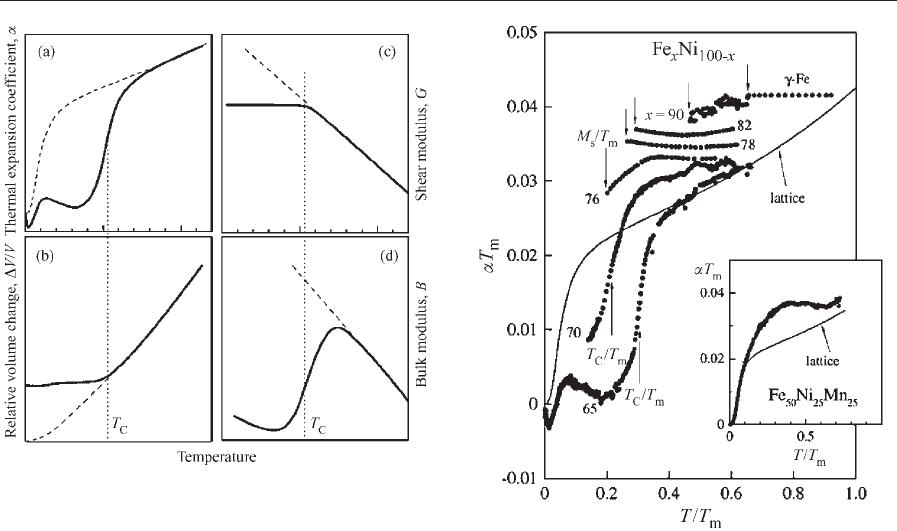
and anti-Invar alloys. A plot of aT
m
¼f(T/T
m
)for
Fe
x
Ni
100x
alloys and elemental iron in the f.c.c.
stability range shown in Fig. 2 reveals the continu-
ous transition from FM Invar behavior in Fe
65
Ni
35
(e/a ¼8.7) to anti-Invar behavior in iron-rich samples
and f.c.c. iron. In Fe
70
Ni
30
(e/a ¼8.6) both effects are
observed, i.e., Invar behavior for ToT
C
/T
m
and anti-
Invar behavior for T4T
C
/T
m
.Forx475 (e/ao8.5)
one encounters only anti-Invar behavior, for which an
example is given in the inset of Fig. 2, showing a(T)of
Fe
50
Ni
25
Mn
25
, a paramagnetic alloy with f.c.c. stabil-
ity to 0 k. With decreasing temperature the anti-Invar
behavior terminates at the martensite start tempera-
ture, M
s
, where the f.c.c.–b.c.c. transition takes place.
Figure 3 shows absolute values of the relative vol-
ume increase, 7DV/V7, vs. the composition (e/a)
caused by the FM and AF Invar effects and the
anti-Invar effect in different f.c.c. alloys. The volume
increases shown occur in addition to the B7.5% in-
crease any metal or alloy experiences in the range
0pTpT
m
because of the ‘‘normal’’ thermal expan-
sion due to anharmonic lattice potential (Gru
¨
neisen
behavior). FM Invar behavior occurs only for e/a4
8.5, while for e/ao8.5 one finds either anti-Invar be-
havior at high temperatures and AF Invar behavior
at low temperatures, or anti-Invar behavior at high
temperatures and martensite at low temperatures, if
the f.c.c. stability is limited.
2. Microscopic Understanding
The present understanding of Invar and anti-Invar
behavior stems from ground state properties as de-
termined in ab initio calculations (Entel et al. 1993,
Herper et al. 1999). A simplified picture is given in
Fig. 4, showing for Invar and anti-Invar the volume
dependence of the total energy E(V) (Figs. 4(a) and
(b)) and the magnetic moments (Figs. 4(c) and (d)).
V
0
denotes the equilibrium and V
c
the critical vol-
ume, where the equilibrium state becomes energeti-
cally unfavorable. In anti-Invar (Fig. 4(a)) the ground
state at V
0
is a low-spin (LS) state with a small mag-
netic moment (Fig. 4(c)) relative to the FM high-spin
(HS) state at larger volumes, causing an enhanced
anharmonicity of the lattice towards larger volumes
V4V
c
in E(V). Invar (Fig. 4(b)) is just the opposite,
because the ground state at V
0
is a FM HS state and
the enhanced anharmonicity in E(V) is towards
smaller volumes VoV
c
, caused by the LS state.
Figure 2
Thermal expansion coefficient a multiplied by the
melting temperature T
m
vs. T/T
m
for f.c.c. Fe–Ni alloys
and f.c.c. g-iron. The upward pointing arrows indicate
the Curie temperatures T
c
. The curves for 70pxp100
are measured down to their corresponding martensite
start temperatures M
s
. The solid curve is the
nonmagnetic Gru
¨
neisen-like lattice reference. Inset:
aT
m
(T/T
m
) for Fe
50
Ni
25
Mn
25
anti-Invar, f.c.c. stable to
0K.
Figure 1
Schematic representation of the temperature dependence
of (a) the thermal expansion coefficient a, (b) the relative
volume change DV/V, (c) the shear modulus G, and
(d) the bulk modulus B for an Invar alloy. The dashed
curves are the nonmagnetic Gru
¨
neisen reference.
337
Invar Materials: Phenomena
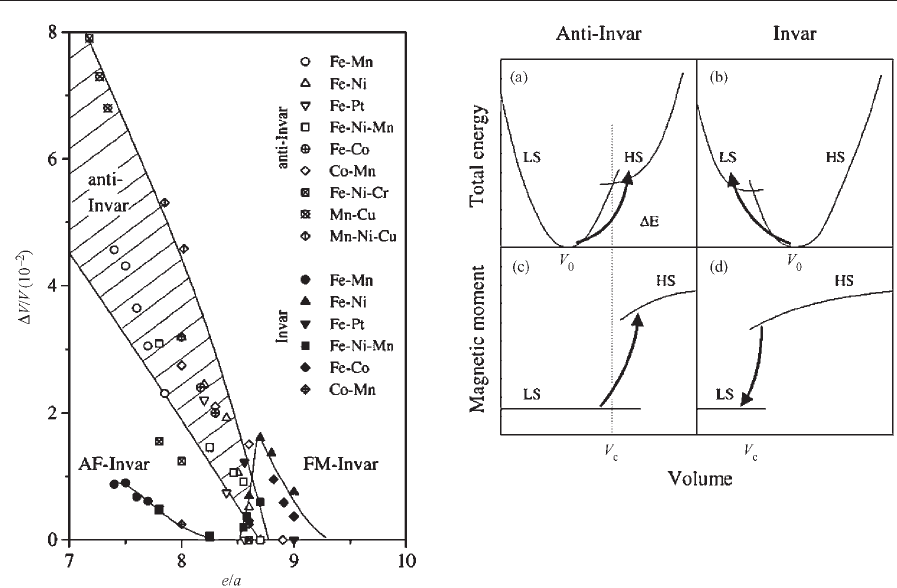
The presence of these moment–volume instabilities
in Fe–Ni and Fe–Pt Invar alloys has been demon-
strated experimentally in Mo
¨
ssbauer experiments
at 4.2 K, showing HS to LS transitions to occur
when the lattice constant is reduced by high pressure
(Abd-Elmeguid and Micklitz 1989). The ab initio cal-
culations also corroborate the systematic behavior
shown in Fig. 3. With increasing e/a anti-Invar
behavior progressively transforms to FM Invar be-
havior as DE, the energetic difference between the HS
and the LS states, decreases, goes through zero (so
that LS and HS states are degenerate) near e/aB8.3,
and then increases again with the HS state becoming
lower in energy.
Concerning the behavior at finite temperatures, the
key point is that DE is of the order of milli-Rydbergs
(1 mRyB150 K), so that transitions from the ground
state to the energetically elevated state are possible by
raising the temperature. Thus, as indicated with the
arrows in Fig. 4, in anti-Invar LS–HS and in Invar
HS–LS transitions occur, and the magnetic moment
increases (Fig. 4(c)) or decreases (Fig. 4(d)), respec-
tively. This is confirmed by high-temperature neutron
investigations on the paramagnetic spin fluctuations
of Fe
x
Ni
100x
alloys within the f.c.c. stability range
(Acet et al. 1997). Figure 5 shows the results in a plot
of the average magnetic moment, m, vs. the temper-
ature for compositions between x ¼65 Invar (dashed
curve) and pure g-iron. With increasing iron concen-
tration the slope of the m(T) curves changes sign, in
accordance with a change from a HS–LS transition
for Fe
65
Ni
35
Invar to a LS–HS transition in Fe
90
Ni
10
anti-Invar or Fe
77
Ni
13
Mn
7
C
3
, an anti-Invar material
with f.c.c. stability to 0 K. The high-temperature spin
fluctuations in Fe–Ni alloys and in f.c.c. iron are al-
ways FM, although at low temperatures AF corre-
lations occur, even AF long-range order in f.c.c. iron
for T
N
o70 K. There is evidence from first principles
calculations (van Schilfgaarde et al. 1999) that non-
collinear magnetic moments and AF short-range or-
der cause additional lattice softening and negative
anharmonicity in Fe–Ni Invar.
Deeper insight into the microscopic background is
gained from calculations resolving the properties of
the d electrons in the vicinity of the Fermi energy E
F
(Entel et al. 1993) with respect to their orbital sym-
metry (t
2g
, e
g
) and their antibonding (AB), nonbond-
ing (NB), or bonding (B) character. The respective
electronic density of states (DOS) curves in the LS
and HS state are shown schematically in Fig. 6. The
Figure 3
Relative volume enhancement 7DV/V7 through FM
Invar, AF Invar, and anti-Invar effect vs. composition in
electrons per atom (e/a) for different f.c.c. alloy systems.
Figure 4
Schematic representation of volume dependence of (a, b)
the total energy and (c, d) the magnetic moment of Invar
and anti-Invar. V
0
, equilibrium volume; V
c
, critical
volume for the transition from the LS to the HS state.
Arrows indicate the direction of response of the system
to increasing temperature.
338
Invar Materials: Phenomena
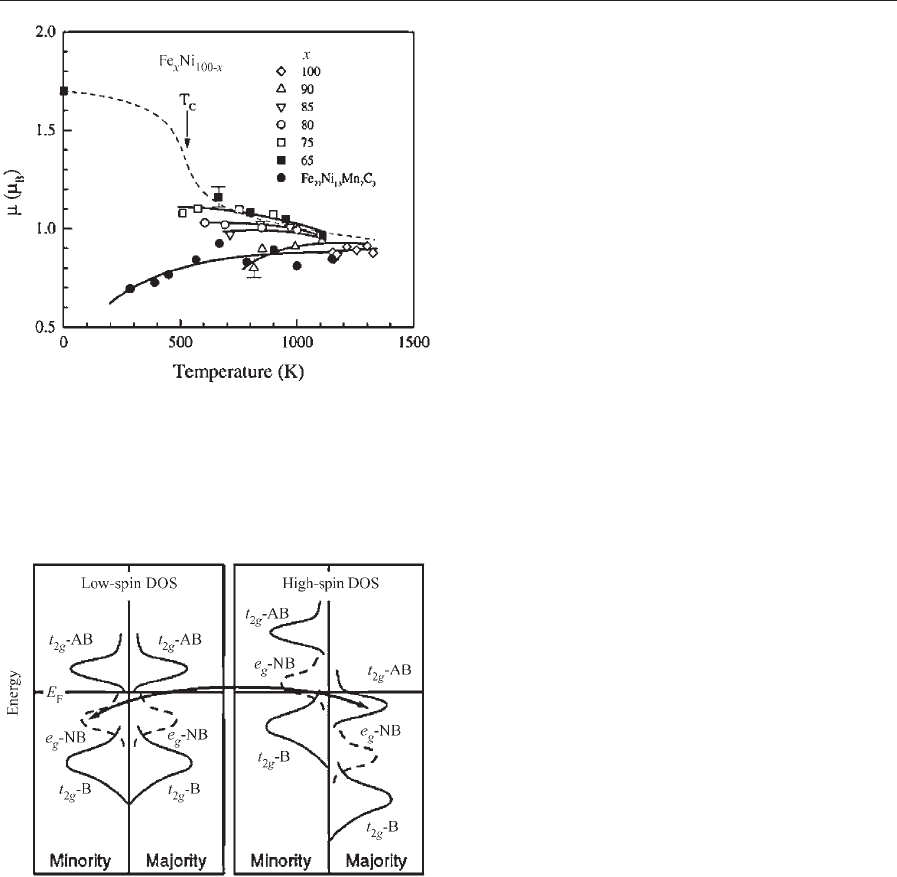
t
2g
orbitals have a maximum charge density in the
[110] direction and thus in an f.c.c. lattice form strong
dds bonds with nearest neighbors. The t
2g
DOS is
therefore split and shows an energetically high-lying
peak with AB character and an energetically low-
lying one with B character. The e
g
orbitals have max-
imum charge densities in the [100] direction and in an
f.c.c. lattice form ddp bonds with the next nearest
neighbors. They are NB and found between the two
t
2g
peaks in the f.c.c. DOS. The position of the Fermi
energy, E
F
, relative to these levels, which depends on
the electron concentration, the atomic volume, and
the temperature, determines which type of transition
occurs between these levels, to lead to Invar, anti-
Invar, or to a martensitic transformation.
The arrow in Fig. 6 indicates the possible excita-
tions with increasing temperature. For anti-Invar
with a LS ground state the arrow reads from left to
right, because there is a charge transfer from NB mi-
nority-spin e
g
orbitals to AB majority-spin t
2g
orbit-
als. These excitations lead to a band splitting and
finally the HS state with a large volume caused by the
AB character of the t
2g
majority-spin states. In Invar
the arrow in Fig. 6 reads from right to left, because
the HS state is the ground state and the charge trans-
fer is from AB t
2g
majority-spin states to NB e
g
mi-
nority-spin states when the temperature is increased.
This reduces the band splitting, corresponding to a
HS to LS transition.
In summary, more than 100 years after the find-
ing by Guillaume, through to the t
2g
–e
g
scenario, the
microscopic background of Invar, Elinvar, and anti-
Invar and also the relationship to the martensite in
iron-based systems is basically understood. However,
the true solution of the Invar problem will be found
when a first principles calculation reproduces cor-
rectly the archetypical property of Invar, i.e., the
anomalous temperature dependence of the thermal
expansion coefficient. To reach this goal a substantial
amount of research is still necessary.
See also: Magnetoelastic Phenomena
Bibliography
Abd-Elmeguid M M, Micklitz H 1989 Magnetism at high pres-
sure in f.c.c. Fe-based alloys. Physica B 161, 17–21
Acet M, Wassermann E F, Andersen K, Murani A, Scha
¨
rpff O
1997 The anomalous temperature dependence of the para-
magnetic response of Fe-rich f.c.c. Fe–Ni. Europhys. Lett. 40,
93–8
Acet M, Za
¨
hres H, Wassermann E F, Pepperhoff W 1994
High-temperature moment–volume instability and anti-Invar
of g-Fe. Phys. Rev. B 49, 6012–7
Entel P, Hoffmann E, Mohn P, Schwarz K, Moruzzi V L 1993
First-principles calculations of the instability leading to the
Invar effect. Phys. Rev. B 47, 8706–20
Herper H C, Hoffmann E, Entel P 1999 Ab initio full-potential
study of the structural and magnetic phase stability of iron.
Phys. Rev. B 60, 3839–48
Van Schilfgaarde M, Abrikosov I A, Johansson B 1999 Origin
of the Invar effect in iron–nickel alloys. Nature 400, 46–9
Wassermann E F 1990 Invar: moment–volume instabilities in
transition metal alloys. In: Buschow K H J, Wohlfahrt E P
Figure 6
Schematic representation of the spin split DOS for a
system with moment–volume instability. DOS in the LS
state (left) and in the HS state (right). The arrow marks
the electronic transitions near the Fermi energy E
F
from
the AB t
2g
majority-spin states to NB e
g
minority-spin
states (arrow from right to left) corresponding to a
HS–LS transition in Invar, and in the reverse direction
for a LS–HS transition in anti-Invar with increasing
temperature.
Figure 5
Average magnetic moment vs. temperature for
Fe
x
Ni
100x
alloys with different x as indicated and pure
g-iron, all within the range of the stability of the f.c.c.
structure. The dashed line is m(T )forFe
65
Ni
35
Invar with
f.c.c. stability to 0 K. The solid curve and the filled circles
are for Fe
77
Ni
13
Mn
7
C
3
anti-Invar f.c.c. stable to 0 K.
339
Invar Materials: Phenomena
